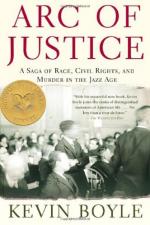Arc of Justice: A Saga of Race, Civil Rights, and Murder in the Jazz Age
by Kevin Boyle
Roaring 20's-WWIIEthnicity & Race
Law

Thesis:
Segregation was illegally protected in Northern cities that struggled to find a place for the wave black migrants coming from the South as part of the Great Migration.
The story of Ossian Sweet's struggle to find a home in the Northern city of Detroit after the Great Migration demonstrates the racism and illegal segregation that became common place in Northern cities. Despite the blatant illegality of mobs attempting to violently dispell someone from a community based on race, the court battle for Sweet was still highly contested. Police tried to cover up evidence but in the end the law could not deny the innocence of the Sweets and their friends/family.
The story of Ossian Sweet's struggle to find a home in the Northern city of Detroit after the Great Migration demonstrates the racism and illegal segregation that became common place in Northern cities. Despite the blatant illegality of mobs attempting to violently dispell someone from a community based on race, the court battle for Sweet was still highly contested. Police tried to cover up evidence but in the end the law could not deny the innocence of the Sweets and their friends/family.
Specific examples/evidence that supports the
thesis:
Summary:
Ossian Sweet
During the 1920s, African Americans from the South poured into northern industrial cities such as Detroit. This migration triggered racial confrontations, as blacks began competing with whites over jobs, schooling, and housing. In 1925, one of those southern black migrants, Ossian Sweet, became a central figure in a confrontation that attracted national attention. Sweet, originally from Florida, was a doctor who sought to establish his practice in Detroit. After he moved into the home he had purchased in a white section of town, an organized mob stoned the house, and some members tried to break in. Anticipating trouble, Sweet had prevailed on friends to help defend his home. They were armed, shots were fired, and one white man was killed and another wounded. Police arrested Sweet, his wife, and nine other black men in the house. The trials that followed were ground breaking for legal challenge of segregation. National Association for the Advancement of Colored People (NAACP) raised money and recruited a legal team for the defendants. The Sweet case set a precedent for the NAACP’s subsequent strategy of using its new Legal Defense Fund to challenge segregation primarily through the courts.
What does this tell us about Ethnicity & Race in the Roaring 20’s-WWII?
What does this tell us about Law in the Roaring 20’s-WWII?
What parts of the book can be applied to lectures?
General Thoughts:
Excerpts from Book Reviews:
"The narrative ranges widely to capture the many dynamic forces that were reshaping the American city and its race relations. These include a rapidly rising black population in Detroit; the role of the real estate industry in building ghetto walls; the use of restrictive covenants to enforce the color line; the significance of local homeowners’ associations in maintaining white neighborhoods; the resurgence of the Ku Klux Klan, not just in asserting white power but as a major force in Detroit politics; and the agency of some African Americans in challenging residential restrictions despite the dangers in doing so."
My Highlighted Passages:
No comments:
Post a Comment